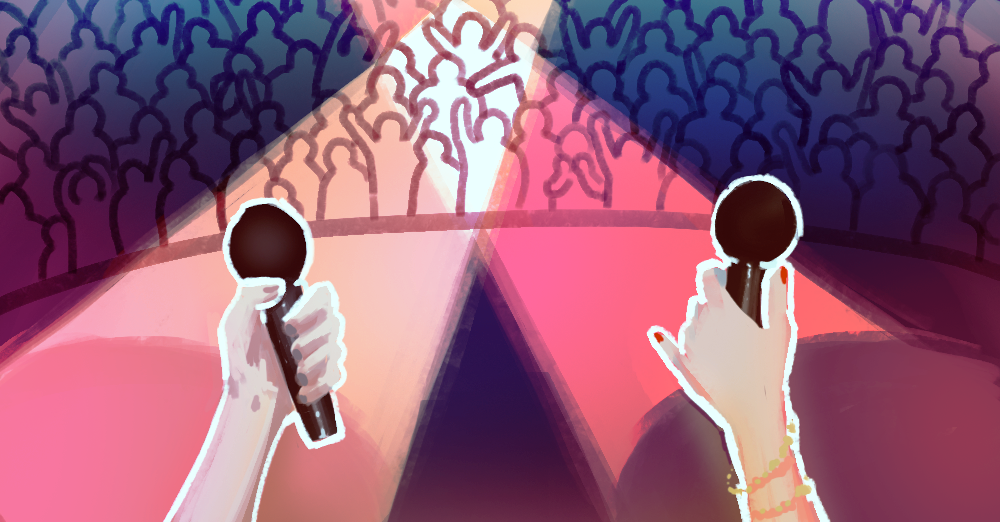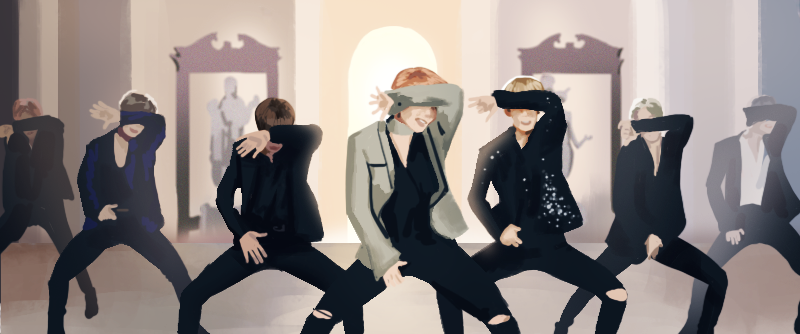It’s time to take Kpop seriously. Every pop culture form reaches a point where the product attains sufficient depth and complexity to merit serious critical attention, as opposed to sociological analysis or entertainment business history chronicling. For western pop, that moment came in 1967, with the release of Sgt. Pepper’s Lonely Hearts Club Band. For Kpop, that time is now. This is Kpop’s Sgt. Pepper moment.
To understand this moment, we need first to consider Kpop’s genesis and growth. Kpop has its origins in the processes that have transformed South Korea in the past two decades. Without the liberalization of Korean society at the end of the 20th century, Kpop would never have come into being. The military government that fell in 1987 had repressed rock and folk musicians as part of a larger policy of maintaining socially conservative norms. As the government democratized, so the media became open to a wider range of voices and styles. As part of this opening, the 11th April, 1992 saw one of the talent shows that were and still are a mainstay of television in Korea broadcast an act that broke with the hitherto dominant ballads and nightclub standards; Seo Taiji and the Boys drew on New Jack Swing and hip-hop in their performance of “Nan Arayo”. Kpop was born that evening. The show’s judges gave “Nan Arayo” the lowest score of the show, older viewers were bemused, but an enraptured younger audience, thrilled by both the new sound and the accompanying dance moves, rushed out the following day to buy “Nan Arayo” and kept it at the top of the charts for four months.
Kpop, however, needed not just liberalization but globalization to thrive. Musicians and producers who had studied and worked in the United States during the 80’s heyday of music videos on MTV returned to Korea with an eagerness to incorporate both new sounds and the American emphasis on visual and styling into a new performance idiom. These music moghuls in the making also learned from both the older African American factory style production of Motown and the more recent music industry innovation of Japan, “idol pop”, a system in which entertainment agencies trained young would – be stars or “idols” not only to perform but to use a contrived “cuteness” to bond with audiences and convert them into devoted followers. Korea fused these elements to create an idol pop industry that trained its idols longer, more intensively, and more comprehensively in song and dance than those of Japan, making them fluent in a Western pop idiom more globally palatable than the distinctively Japanese musical style of Tokyo’s idols. As Korea developed one of the world’s fastest and most comprehensive broadband internet networks at the beginning of the new millennium, the physical sales of recordings in Korea collapsed. Undaunted, the Kpop industry, now dominated by a small group of entertainment agencies, recognized YouTube not as threat but as an opportunity to follow the Korean pattern of export led growth. Catchy music videos in eye popping colors joined Korean TV dramas and films to form the hallyu or Korean wave that swept out beyond Korea and Asia to reach anyone on earth with access to an internet connection. The South Korean government, proud of this new Korean cultural export and hopeful that openness to Korean music videos today would facilitate openness to Korean capital and consumer goods tomorrow, began to support the Kpop industry. Korean popular music, as the worldwide success of 2012’s Gangnam Style demonstrated, was both a consequence and catalyst of globalization. The contrast with the Japanese pop industry illuminates that of Korea. The Japanese music market is, after that of the USA, the largest in the world; consequently, the music industry in Japan, unlike that of Korea need not depend on exports. A combination of vigilantly enforced licensing arrangements and marketing that links physical sales with opportunities to participate in idol culture has kept the CD alive as an important music medium in Japan. Hence those searching for Jpop on YouTube will find little to compare with the abundance of Kpop. Instead of Kpop’s plethora of easily searchable, English titled music videos and an accompanying ecosphere of English language fan sites and guides, sparse pickings of unsubtitled, truncated videos of a music making few concessions to non-Japanese listeners await those curious about Jpop – if they are not already disappointed by the multitude of black screens showing Japanese record labels’ copyright strikes. Meanwhile the Kpop industry has used online music videos to promote concert and merchandise sales, physical sales in which the CD is an oft never to be played afterthought to the accompanying collectibles of photobooks and cards, and lucrative commercial endorsements. These endorsements make Kpop idols ubiquitous in the Korean retail and media landscape, recommending everything from cars and consumer electronics to cosmetics and fried chicken. This commercial presence is not limited to Korea, as Kpop idols start to appear in fashion spreads and advertisements in Asia and beyond. Kpop not only provides the soundtrack to the development of a globalized capitalism, but is itself part of that process.
The integration of Kpop into global consumer capitalism might seem to confirm the worst fears of Theodor Adorno. The Frankfurt school theorist heard what he thought of as the impoverished musical idiom of the popular music of midcentury America and denounced the growth of “regressive listening,” an involvement with music less active engagement on the listener’s part than a process of auditory incorporation into the dehumanized world of advanced capitalism. Clichéd harmonies and repetitive rhythms would reduce listeners to a state of alienated docility, a state in which the radical critique of society is made unthinkable. One does not have to accept Adorno’s critical theory en bloc, still less agree with his championing of the modernist avant-garde as the only musical exit from “regressive listening”, to acknowledge the interpretive possibilities of his linkage of music to social structure and ideology.” The runaway success of girl group Twice not just in Korea, but also in Taiwan, Hong Kong, Japan, and Southeast Asia tells us something about the development of capitalism in this region; watching Twice music videos might also tell us that the transnational flows of investment, goods, and services in this region have been accompanied by the promulgation of cultural norms of childishness antithetical to the life of critical citizens but closely aligned to the unreflective existence of politically inert consumers. Twice’s “Knock Knock” could exemplify Adorno’s nightmare, its repetitiveness pummeling the listener into infantilism.
Yet closer investigation of Kpop’s social dimension reveals a more complex picture. In Seoul, students from Ewha Women’s University initiated the 2017 political upheaval that toppled President Park Geun-hye from power; as the insurgent students marched, they sang Kpop — Girls’ Generation debut single, “Into The New World.” Even the bubblegumish Twice can offer more than Frankfurt style pop culture pessimism suggests. Although “Likey” will not please those convinced that the Second Viennese School blazed a trail we should be following even now, the recording production, rapping, and use of electronic drums and keyboards make the song worth a second and closer listening – particularly since these elements that have not always been appreciated by those schooled in an art music tradition. Thematically, the “Likey” music video offers a by no means simple minded approach to the presentation of the self on social media. Reacting against the broad brush condemnations of Adorno should not, on the other hand, lead us to paint Kpop with the glowing colors offered by those academic successors to and antagonists of the Frankfurt School, theorists inspired by the Birmingham Centre for Contemporary Cultural Studies. In the 80s and nineties this approach led to academics in humanities and social science departments vesting products of pop culture with a political significance that in retrospect seems difficult to justify even in the case of some of the more self-consciously radical material of those decades. Not only does much of Kpop seem difficult to accommodate within the neomarxist and feminist frameworks of cultural studies, but also the motivation behind the attempt seems suspect. All too often behind the Franco-German academese of the Anglophone cultural theorist one can hear the sermonical tones of the moralizer preaching that a work of art’s merits consist in its tendency to better society. Ethics may not be the enemy of aesthetics, but moralizing certainly is. Notwithstanding the Ewha student march, Kpop’s merits as art lie less in its capacity to effect social change than in its promise as a field of artistic production in which form and content can unite to deepen and elaborate our emotions, our sensibilities, and our imaginations. That pop music can do this has been a critical commonplace from at least the time of Sgt Pepper; now is the time to make a similar claim about Kpop.
To justify this claim, the first name that springs to mind is BTS. That boy group’s current commercial salience in North America lies in their success in moving beyond — but not deserting — a fanatically loyal niche fanbase in the west to win over not just boy band lovers mourning the loss of One Direction, but also a wider teen audience delighted to discover seven attractive but unthreatening young men who dance in tight formation on smartphone screens and make themselves available to fans on Instagram and Twitter. Yet even if social media helped BTS get two albums to the number one spot in the Billboard 200 in less than a year, their successful marketing has depended not just on technology but also on artistry. “Authenticity” animates the band’s joint Twitter account, but more importantly, the creation of their material too. Unlike so many Kpop idols, BTS write and produce much of their music, thus allowing them to shed the stigma of “manufacture” that has alienated so many Kpop groups from those English speaking audiences who prize “authenticity” above all.
The BTS concern with authenticity extends beyond the manner of their music’s creation to its actual content, as the title of “Fake Love” suggests. In addition to authenticity, BTS promise to address other themes weightier than the standard Kpop preoccupations of teen romance. This ambition shapes “Blood Sweat &Tears”, the single that did more than anything to present BTS and Kpop in general to the west as something more than a novelty. Crucially, this presentation took place via YouTube – in Kpop, just as in opera or the musical, the visual is essential – making the music video central to an evaluation of “Blood Sweat &Tears” as a serious work of art. The video leaves the viewer in no doubt about the seriousness of intention – just as the music links tropical house synth, cascading falsettos, and a bluesy bridge to German baroque organ, so the visuals tie precision choreography with Michael Jackson inspired crotch grabbing to fallen angels, allusions to Herman Hesse and Nietzsche, and a lush androgyny that echoes fin de siècle decadence not only in its look but in the paramount importance ascribed to Art – with a capital A. Therein lies what could be one of two central problems with BTS as ambassadors of “serious” Kpop. In spite of the undoubted virtuosity of the musical and visual production, the high art references do not so much emerge from the opening hook of the chorus and the EDM textures as clothe them. The BTS costuming of catchiness with culture might exemplify kitsch in the proper sense of that term – the pretentious disguise of industrially produced convention with the trappings of High Art. Kitsch is necessarily inauthentic, which points to the second problem with taking BTS seriously, regardless of any pretensions on their part. “Authenticity” might make sense as a criterion of excellence when applied to acoustic guitar strumming singer songwriters or struggling garage band rockers, but is surely out of place in considering the material produced not just by BTS but by the Kpop industry as a whole, material created — or manufactured — by the complex and collective process of combining highly produced music with visuals, styling, and choreography. Just as film critics came to understand that they did not need the concept of the director as auteur to evaluate the product of the Hollywood art-industrial complex, we need not spend time thinking about authenticity or its absence as we try to make sense of the musical offerings of the Seoul pop machine. But if authenticity doesn’t matter, then BTS can’t tell us why we should take Kpop seriously.
The answer to that question might lie in the Loona project, a musical enterprise that could turn out to be as important to Kpop as Sgt Pepper was to its western analogue. Loona is a 12 member girl group with a member by member solo rollout that started in October 2016 with HeeJin’s “ViViD” and finished in March 2018 with Olivia Hye’s “Egoist”. In addition to the individual solos and sidetracks, BlockBerry Creative, the entertainment agency behind Loona, have combined members in subunits — Loona 1/3, Odd Eye Circle, and yyxy — each with their own lead titles and albums. The 12 members came together as one group to debut at the end of August 2018 with two titles, “favOriTe” and “Hi High”, and BlockBerry released “Butterfly” in February 2019. Meanwhile observers of the Kpop business have joined with Loona’s already sizeable international fandom to speculate on BlockBerry’s ultimate goal. Given the massive expense of the lengthy introductory process, with location shooting not just in Tokyo and Taipei but also in London and LA, taking in Iceland, France, Hungary, and New Zealand along the way, BlockBerry can’t be hoping for a swift return on investment. The project might be a loss leader for BlockBerry as it tries to establish itself as a major agency in the Korean entertainment industry, or it could be a project created for artistic rather than purely commercial purposes, a creative vision made realizable by the deep pockets of BlockBerry’s owners, the industrial conglomerate Ilkwang group. Whatever the commercial strategy, the business structure of the Loona project precludes any talk of “authenticity”, as nobody pretends that Loona’s members are anything other than employed performers. Yet the Loona project is not an exercise in pandering to self-conscious inauthenticity, the sensibility first noted in Susan Sontag’s “Notes on Camp” and found today at Eurovision parties replete with air quotes and ironic consumption. Instead, the introductory phase of the project alone has succeeded in producing a set of music videos that can stand as a work of art at once entertaining, inspiring, and enigmatic. Kpop might have previously produced material that is musically challenging – “Red Light” by f(x) – mythopoetic – Oh My Girl’s “Closer” – or dramatically dense, as in VIXX’s Blade Runner-cum-Romeo and Juliet “Error”, but never before has Seoul managed to present a body of work that might be the equivalent of the Beatles’ transition from moptops to major artists.
The comparison is, like all analogies, inexact. If Sgt Pepper represented the Beatles’ maturation as artists, the Loona project stands for something more like the artistic efflorescence of a motion picture genre. So westerners new to Kpop but curious about Loona will first have to put aside the “authenticity” fetish and adopt a receptive mindset closer to that of devotees of the film musical or opera. Other prejudices must be dropped too. Although Loona, like all Kpop groups, perform material composed in the musical language of Euro-American pop, albeit with a Korean inflection, the conceptual content of the music videos, some of which turns on a distinctively East Asian presentation of school student passions, might pose a challenge to some western viewers. Prudish conservatives will have to tolerate the depiction of intense same sex affection, while those prurient viewers hoping for something like the sapphic schoolgirls of Pornhub will be disappointed; as is usually the case with Kpop, the videos show nothing that would endanger a G rating in the USA. This absence of the explicit reflects less the puritanism of Korea than the thematic depth of the whole project. From the teen crush motifs of the videos there emerge organically questions that matter as much to 60 year olds as to school age fans, puzzles equally important to the monogamous and the polyamorous, the heterosexual and the queer. How do the passions of love relate to the affections of friendship? What sort of self acceptance must precede engagement with others? Is love an illusion, or the deepest insight of which we are capable?
To explore these themes in the Loona project, western audiences should begin with the videos of the Odd Eye Circle subunit. The sinuous R ‘n’ B rhythms of Kim Lip’s “Eclipse” provide an easy entrée to the Loonaverse, with the future bass sound of JinSoul’s “Singing in the Rain” proving equally accessible. “Love Cherry Motion”, featuring Choerry, the third member of the Odd Eye Circle subunit, offers both musical and visual surprises. These surprises link Choerry’s song to those of Kim Lip and JinSoul, and in doing so reveal the elemental currents of desire and imagination coursing beneath the surface of the everyday. So primed, the listener can now move onto the looped structure of “Girl Front” and the gorgeous visuals of “Sweet Crazy Love”. Following immersion in the dreampop of Odd Eye Circle’s “Loonatic”, explorers can make their way into the music of the Loona 1/3 subunit. For westerners, as opposed to Koreans, the “cuteness” on display with Loona 1/3 might prove an initial obstacle; a musical, visual, and performing style which emphasizes youthful innocence, sentimental bonding, and the delicate expression of adolescent yearning can seem insipid to westerners whose pop culture palates are habituated to regular servings of raunch. Nevertheless, if one perseveres rather than prejudges, Loona 1/3 will offer a rich musical reward with “Sonatine”, in which percussionless strings and piano, a tango interlude, and adventurous harmonies come together to sound out new possibilities in pop. Finally, the yyxy subunit plunges us into a world of same sex yearning, rejection, and love. The solo videos of this subunit and the Loona introductory project conclude with the rooftop scene of “Egoist,” where Olivia Hye, having learned to embrace herself, stands face to face with HeeJin, whose solo commenced the project. In the latter months of 2018, Loona debuted as a twelve member group with not one but two titles: “favOriTe” a brass laden dance number, aimed at international fans, and “Hi High,” three and a half minutes of bubbly exhilaration made both to appeal to a Korean audience and, through an abundance of musical and visual references, to act as a coda to the twenty seven music videos that introduced the individual members and subunits of Loona. In February 2019, Loona opened a new chapter with the release of “Butterfly”. In this music video, Loona turn outward to address young women diverse in color, creed, and condition around the globe. The synthpop instrumentals and processed vocals blend with dance that transcends the gendered standards of most kpop choreography; meanwhile the images of the video at once address the needs for freedom and flourishing while echoing and elaborating upon scenes from the earlier videos.
Exactly how these videos fit together is debatable. Debated the videos certainly are, as demonstrated by the page upon speculative page a search on “Loona AND theory” yields. Moebius strip analogies and biblical references jostle with competing chronologies and narrative frameworks in multiple attempts to make sense of the Loonaverse. Notwithstanding the geekish joy this world building can offer, the real challenge of taking this Kpop seriously is to our critical rather than our puzzle solving faculties. As Loona fan Grimes introduces the yyxy subunit’s “love 4eva” we can hear at once the opening of a bubblegum pop single crafted to appeal to Korean teens and tweens, a witty homage to the foundational Girls’ Generation hit “Gee”, and the beginning of a music video in which the joyous luminescence of the dance pop melody underlines the darkness of the video’s presentation of estrangement and abandonment.
If we go back to review the Loona project as a whole, we might also hear two voices at our sides that disagree about taking Kpop seriously. One belongs to the advocate of “honest pop”, moaning that just as Sgt Pepper opened the door to years of bloated concept albums, so the Loona project will suffocate the glitzy fun of Kpop in mounds of pretension. The other, which we will do well to heed, belongs to that cousin of Lucy in the Sky with Diamonds, Choerry of “Love Cherry Motion”. She’s urging us to follow her into another dimension with her repeated whisper of “Ah ah, imagine!” •
Images illustrated by Barbara Chernyavsky.







